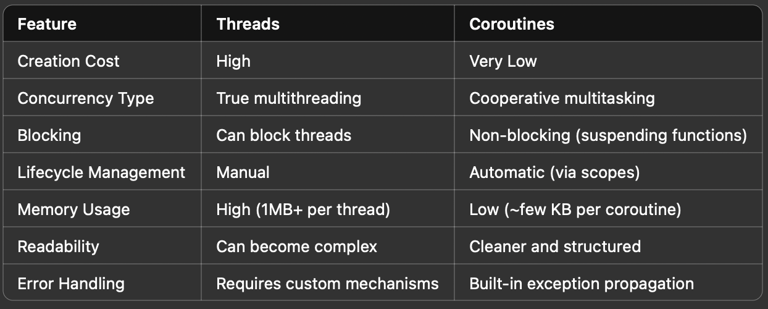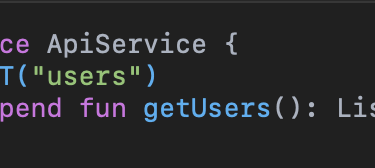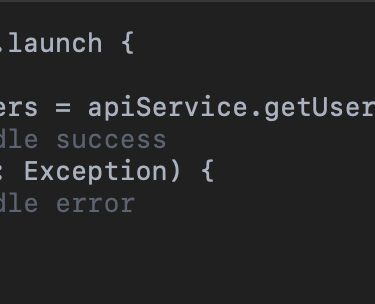Kotlin Coroutines vs Threads: What Every Android Developer Needs to Know
Discover the key differences between Kotlin Coroutines and Java Threads. Learn how coroutines simplify async programming, boost performance, and make your code cleaner—especially when using libraries like Retrofit.
TECHMOBILEBACKEND
Laura Oliveira
4/9/20254 min read


In the world of software development, especially in Android and backend development, two powerful tools stand out when it comes to managing concurrent processes: Threads and Coroutines.
Both serve a similar purpose—handling multiple operations that may occur simultaneously. However, the way they operate and the developer’s role in managing them are vastly different.
In this post, we’ll explore what coroutines and threads have in common, how they differ, and why Kotlin coroutines are becoming the go-to solution for modern development. Whether you’re building API calls with Retrofit or managing UI operations, understanding these concepts can help you write more efficient, readable, and scalable code.
🔁 What Do Threads and Coroutines Have in Common?
Let’s start with the basics. Both threads and coroutines are mechanisms to run concurrent tasks, which means they allow multiple operations to take place at the same time without blocking each other.
💡Imagine you’re planning a trip:
You’re checking flight prices;
You’re comparing hotels;
You’re looking up local SIM card options.
These activities can happen concurrently without waiting for the other to finish. In programming, we often refer to such sets of activities as processes or tasks, each with its own lifecycle—starting, running, and completing.
Whether you use threads or coroutines, you’re essentially managing multiple tasks that may or may not depend on each other. Both approaches aim to optimize time and resources.
🧵 What Are Threads in Programming?
Threads have been around for decades and are widely used in languages like Java. A thread is a unit of execution within a program. When you create a new thread, you’re essentially spinning off a new path for the application to execute code in parallel with the main process.
🧠 Pros of Using Threads:
Suitable for heavy, CPU-bound operations;
Supported natively in Java, and well-documented;
Useful when running truly parallel tasks on multi-core CPUs.
⚠️ But Threads Also Have Limitations:
Creating too many threads consumes memory and CPU resources;
You must manually manage synchronization and avoid race conditions;
Code becomes harder to read and maintain when multiple threads interact.
Threads are like managing a team of people individually—assigning them tasks, checking progress, and ensuring they don’t step on each other’s toes. It works, but it can get messy quickly.
🔄 What Are Kotlin Coroutines?
Enter Kotlin Coroutines, a modern solution to simplify asynchronous programming. A coroutine is a lightweight thread-like structure that doesn’t block the main thread while waiting for a task to complete. It was introduced to reduce the complexity of managing multiple threads, especially for I/O-bound operations like network calls or database access.
Kotlin’s coroutine system is fully integrated with libraries like Retrofit, making it incredibly easy to perform asynchronous API calls without boilerplate code.
🚀 Benefits of Coroutines:
Lightweight: You can launch thousands of coroutines without performance issues;
Structured concurrency: Coroutines follow a parent-child hierarchy for better control;
Built-in lifecycle awareness: Especially useful in Android development with ViewModel;
Cleaner code: Say goodbye to messy callbacks and thread handling.
In simple terms, coroutines are like booking your entire trip using an app that automates everything for you. You focus on what needs to be done, not how to manage each step manually.
🤖 Threads vs Coroutines: A Side-by-Side Comparison
💡 Practical Example: Retrofit with Coroutines
When using Retrofit in Kotlin, you can define your API service like this:
By marking the function with suspend, you’re telling Kotlin this function is a suspending function and should be called from within a coroutine.
Then, in your ViewModel or repository:
No threads, no callbacks, no AsyncTask. Just clean, concise, and readable code.
👩💻 Why Developers Prefer Coroutines
Coroutines free developers from the low-level details of thread management. They allow us to write asynchronous code as if it were synchronous, which is easier to reason about, test, and maintain.
💡Here’s why coroutines are a game-changer:
• UI stays responsive: Long-running tasks won’t block the main thread.
• Cleaner error handling with try-catch.
• Less code, better performance.
Especially in Android development, coroutines pair beautifully with components like LiveData, StateFlow, and ViewModel, enabling powerful MVVM architectures.
📌 Final Thoughts
Threads and coroutines both aim to handle multiple processes efficiently, but coroutines take a modern, developer-friendly approach. They abstract away the heavy lifting, reduce boilerplate, and help you avoid common pitfalls of traditional multithreading.
If you’re working with Kotlin, especially in Android apps or backend systems using Ktor, there’s no reason not to use coroutines. They simplify your code and boost performance—letting you focus on building features, not debugging threads.






Laura Oliveira
Mobile Developer and Content Creator
Fascinated by technology since she was a teenager, she loves solving problems and learning new things.
I currently work bringing ideas to life for Android apps.
I have +2 million people impacted through the production of digital content.


2M+
3
Years Creating Content
Content Reach
